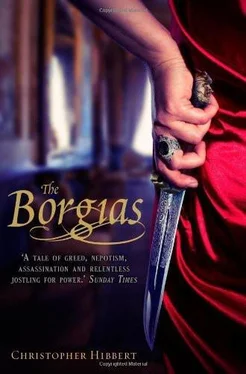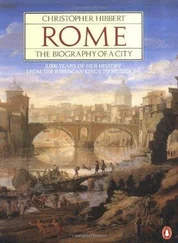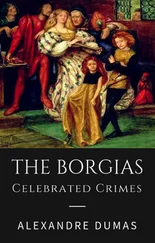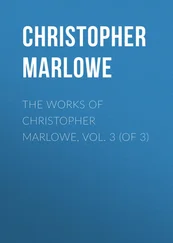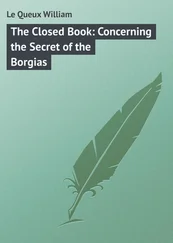The city seethed with excitement; one Ferrarese diarist spoke for many when he responded to one man who thought the festivities ‘a gross inconvenience, but in my opinion he was speaking like a fool.’
The city’s leading families competed with each other for the honour of providing a daughter to join the bride’s new household and prepared apartments in their palaces to accommodate the official guests who had been invited. Ambassadors arrived from Lucca, Florence, and Siena; the Venetian embassy numbered 150; around the necks of the French embassy, met by the duke in person, one observer counted eighty-four heavy gold chains, worth, he thought, some 35,000 ducats. There were ‘so many visitors in Ferrara,’ he noted, ‘that it was almost impossible to believe.’
Finally, late in the clear, cold afternoon of February 2, the Feast of Candlemas, Lucrezia rode across the bridge over the Po at Castel Tedaldo to enter the city that would be her home for the rest of her life.
Eighty trumpeters led the cavalcade, followed by a hundred mounted crossbowmen, all dressed in the red-and-white Este livery and wearing caps made in the French style, a mark of honour to Louis XII, whose alliance with the pope and Cesare had precipitated the marriage. Next came the heralds wearing black-and-gold tabards and carrying silver trumpets, followed by drummers riding white mules, by armed halberdiers, by mounted pages and nobles and bishops and ambassadors, a gaudy array of gold and silver, red and purple, velvets and silks, and costly fur-lined cloaks — the Spanish courtiers of Cesare’s household provided a sober contrast in their customary plain black.
Spontaneous cheers greeted the bridegroom Alfonso, who was splendidly dressed in grey velvet embroidered with gold — the embroidery alone was said to be worth 8,000 ducats — and a cap trimmed with feathers, riding with his squires astride a superb bay charger caparisoned in purple velvet. Then came the bishops, in white copes and jewelled mitres; the ambassadors in their official finery; and then the drummers and jesters, who heralded the arrival of the bride. This was what the crowds had been waiting for, and they roared their approval.
Riding a snow-white horse with gold trappings, Lucrezia entered Ferrara beneath a white silk canopy decorated with gold fringe, which was carried by eight doctors of the university. She wore a jewelled coif on her head, its value estimated at 15,000 ducats, one of the caps that, as Isabella d’Este acidly remarked, ‘my lord father sent her in Rome,’ adding, ‘Around her throat was the necklace which had belonged to my mother.’ On her feet was a pair of slippers worth 2,000 ducats, and she wore a dress of gold brocade striped with purple satin, ornamented, according to one observer, ‘with so many jewels that it was a marvel,’ with a gold cloak thrown back over one shoulder to display its ermine lining.
Behind her came several open carriages bearing numerous Ferrarese ladies and other guests and, last of all, the long line of pack mules carrying the chests filled with her clothes, jewellery, and other possessions, their loads covered with lengths of deep red satin embroidered with her own device.
Lucrezia’s mount, an elegant bay horse, was startled by the sudden deafening roar of artillery from Castel Tedaldo that sounded as she crossed the bridge, and it reared up, throwing her to the ground. Fortunately she was not hurt but picked herself up, laughing merrily, ‘and this I saw myself because I was right there,’ wrote one observer of the event. A mule was brought for her to continue, and she made her way through the narrow winding streets, past the entertainments staged for her at every turn, and finally into the great piazza in front of the ducal castle.
The piazza was crowded with people, ‘so full,’ remarked one observer, ‘that if a grain of millet had fallen from the sky it would not have reached the ground.’ The arrival of the cavalcade was heralded by a tremendous fanfare from the 113 trumpeters and pipers playing on the balcony of the ducal palace, and the dungeons beneath were opened to release a stream of prisoners. Two men then descended down ropes from the top of the high towers in the piazza, their arms outstretched so that ‘they looked like birds,’ as one man said, to land at Lucrezia’s feet. Zambotti commented that ‘everyone thought it a great marvel because it happened so quickly and neither of them was hurt.’
Lucrezia rode into the courtyard of the palace, where she dismounted and climbed the marble staircase, at the top of which Isabella d’Este and other female members of the ducal family waited to embrace her before escorting her into the Great Hall, which had been hung with cloth-of-gold ‘and silks of great value’ to mark the occasion. There she was guest of honour at the feast, the highlight of which was a series of life-size sculptures all made in sugar, followed by a ball.
At the end of the evening, the bridal couple made their way to their bedchamber in the apartments that had once belonged to Alfonso’s mother. The following day, the bridegroom’s father reported to the pope: ‘Last night our illustrious son, Don Alfonso, went to bed with his wife, and from all accounts, it appears they were quite satisfied with one another.’ Her husband seemed pleased with her and was attentive for the first few days, even though he did not linger for long of a morning in their bed, but, having slept with her, so the Ferrarese ambassador to Rome told the pope, he ‘took his pleasure with other women during the day.’ ‘Being young,’ the pope had commented, complacently, ‘it does him good.’
The phlegmatic, silent bridegroom, a man whose interests, so it was said, were limited to sewers and artillery, had regarded his marriage as no more than a painful duty. The two women he had most deeply cared for had both died young; his mother, Eleonora of Aragon, the sister of King Federigo, had died when he was seventeen years old; his younger sister, Beatrice, had died in childbirth four years later. Alfonso’s secretary thought it was interesting to speculate on his master’s feelings toward the bride in whom he had appeared to show no initial interest. As he came to know Lucrezia better, however, the more interesting and attractive he found her; he actually sought out her company, grateful to have reason to disbelieve the stories of her debauched past. ‘Whatever his feelings were before he met her, before long he conceived,’ so it seemed to the secretary, ‘a love as ardent as was the aversion he had felt for her when the marriage had first been proposed.’
The wedding festivities continued for over a week. There were jousts most days in the great square in front of the palace, followed by banquets and balls every night. A troupe of actors performed the comedies of Plautus each afternoon, which the duke, determined to show off the quality of culture for which Ferrara was justly famous, had insisted were to be better than anything that Lucrezia would have seen in Rome. There were also the customary ceremonial offerings of presents to the bride and groom. The Venetians produced two superb mantles of deep red velvet, worth 300 ducats each. The French ambassador had brought expensive gifts from Louis XII: a rosary for Lucrezia, its beads of perforated gold filled with aromatic musk, and a shield for Alfonso, decorated with the figure of Mary Magdalene, which, the ambassador was at pains to explain, was to show that he had taken a woman of virtue, though all of those present had heard the rumours of incest and many believed that Lucrezia’s past, like the Magdalene’s, had been far from virtuous.
Lucrezia, it seems, thoroughly enjoyed the parties. Zambotti described her as being ‘full of life and gaiety.’ The pope’s daughter, so it was agreed, danced ‘admirably’ and dressed ‘beautifully.’ Duke Ercole was full of praise for the daughter-in-law he had been so reluctant to accept and seems to have become genuinely fond of Lucrezia, taking her, as a mark of his favour, to visit Sister Lucia da Narni, the nun she had helped to move from Viterbo to Ferrara. ‘Her virtues and good qualities have so pleased me,’ the duke wrote to Alexander VI about Lucrezia, ‘that she is the dearest thing I have in this world.’
Читать дальше
